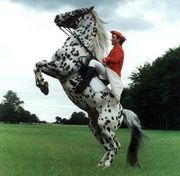Leopard pattern

A leopard pattern is a spotted color pattern, particularly in the hair coat or skin of animals, but also used to describe spotting patterns in plants and fabrics. The term is refers to the black and gold spotted coat of the Leopard cat, but is used to describe many color combinations that result in spots scattered randomly across the skin or hair coat of other animals.
Examples of animals with coloring patterns termed Leopard include many great cats in the Panthera species, the Leopard frog, the "Leopard" spotting pattern in the Appaloosa and Knabstrupper breeds of horses, the Leopard Seal, insects such as the Giant Leopard Moth, and fish species such as the Leopard darter and the Leopard shark. Examples of plants that use the term include the Leopard Lily, and the Leopard flower.
The Lp (Leopard complex) gene is responsible for the leopard color pattern in horses, which not only produces a spotted coat color but also causes mottling of the skin, a white sclera around the eye, and striped hooves. Horses with the Lp gene may be spotted all over, or may have concentrations of spots in various patterns.
-
A Leopard-patterned Knabstrupper horse



